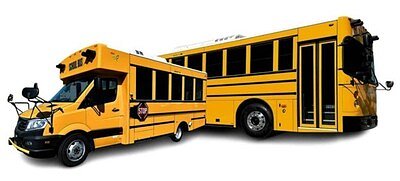
GreenPower Accelerates Electric School Bus Production with $18M Funding Boost
GreenPower Motor Company secures financing to scale production of its all-electric school buses, aiming to capitalize on growing demand and federal incentives driving the transition to zero-emission transportation.
The Road Ahead: GreenPower’s Bet on Electric School Buses
By Janet Adams
Porterville, CA – GreenPower Motor Company is doubling down on its commitment to electric school transportation, securing up to $18 million in funding to accelerate production of its all-electric Nano BEAST and BEAST school buses. This investment arrives as demand for zero-emission school transportation surges, fueled by growing environmental concerns, tightening regulations, and increasingly attractive federal incentives.
While many companies are entering the electric vehicle space, GreenPower distinguishes itself by focusing exclusively on medium and heavy-duty vehicles – specifically, a niche currently underserved: purpose-built electric school buses. The company claims to be the only OEM manufacturing both Type A and Type D electric school buses, offering school districts a wider range of options to meet their specific needs.
“The timing is right for a dedicated player in this market,” said one industry analyst, speaking on background. “The infrastructure is starting to mature, the incentives are becoming more substantial, and schools are under increasing pressure to reduce their carbon footprint.”
Funding Details & Strategy
The financing comes in the form of Series A Convertible Preferred Shares, structured to allow GreenPower to deploy capital in tranches of up to $2 million, aligning funding with production schedules and optimizing cash flow. The deal includes a 9% annual dividend on the preferred shares, alongside conversion features that could dilute existing shareholders if the shares are converted into common stock.
The strategic advantage of this funding structure, explains a financial source familiar with the deal, is that it provides GreenPower with “flexible capital,” allowing them to scale production without taking on excessive debt or diluting equity too aggressively. “It’s a calculated risk that allows them to capitalize on the rapidly growing demand without overextending themselves.”
Navigating a Growing Market
The electric school bus market is poised for significant growth, driven by several key factors. The EPA’s Clean School Bus Program, which provides funding to replace diesel buses with zero-emission alternatives, is a major catalyst. State-level incentives, such as California’s HVIP, further reduce the upfront cost barrier for school districts.
“The incentives are crucial,” explained a school district transportation director, speaking anonymously. “Without them, the upfront cost of electric buses is simply too high for many districts to justify, even with the long-term operating savings.”
However, the transition isn’t without challenges. The availability of charging infrastructure remains a significant hurdle. School districts need to invest in charging stations and ensure they have sufficient grid capacity to support a fleet of electric buses. The range of electric buses, while improving, can still be a limitation for certain routes.
“We’re carefully evaluating the total cost of ownership,” said the transportation director. “That includes the cost of the buses, the charging infrastructure, and the ongoing maintenance. It’s a complex calculation, but we’re committed to exploring all options.”
GreenPower’s Differentiation
GreenPower’s strategy is centered around purpose-built electric vehicles, a key differentiator in a market where many companies are retrofitting existing chassis. The company's Nano BEAST and BEAST buses are designed from the ground up as electric vehicles, allowing for optimized battery placement, weight distribution, and range. The Nano BEAST, a Type A bus, boasts a 118 kWh battery pack and a range of up to 140 miles, making it suitable for shorter routes and urban environments. The BEAST, a larger Type D bus, offers greater capacity and range for longer routes.
“Designing from scratch allows us to optimize every aspect of the vehicle for electric propulsion,” explains a GreenPower engineer, speaking on background. “We can maximize battery capacity, improve efficiency, and enhance safety.”
However, GreenPower isn’t operating in a vacuum. Competition in the electric school bus market is intensifying, with established automakers and startups vying for market share. Companies like Lion Electric, Blue Bird, and IC Bus are all developing electric school buses, and new entrants are emerging regularly.
“The competitive landscape is definitely heating up,” said the industry analyst. “GreenPower needs to continue innovating and differentiating itself to stay ahead of the curve.”
Looking Ahead
GreenPower’s recent funding injection positions the company to capitalize on the growing demand for electric school buses. By focusing on purpose-built vehicles, leveraging government incentives, and addressing the challenges of charging infrastructure, GreenPower aims to become a leading player in the transition to zero-emission school transportation.
The company is currently scaling up production at its facilities in South Charleston, West Virginia, and Porterville, California. It plans to deliver 88 all-electric school buses in West Virginia and aims to reach a production target of 50 to 60 purpose-built school buses per quarter.
“We’re committed to delivering clean, safe, and reliable school transportation,” said a GreenPower spokesperson. “We believe electric school buses are the future, and we’re excited to be at the forefront of this revolution.”
Ultimately, the success of GreenPower, and the broader transition to electric school buses, will depend on a confluence of factors: government policies, technological advancements, and the willingness of school districts to embrace a cleaner, more sustainable future. But with the right ingredients in place, the road ahead looks bright for electric school transportation.
📝 This article is still being updated
Are you a relevant expert who could contribute your opinion or insights to this article? We'd love to hear from you. We will give you full credit for your contribution.
Contribute Your Expertise →